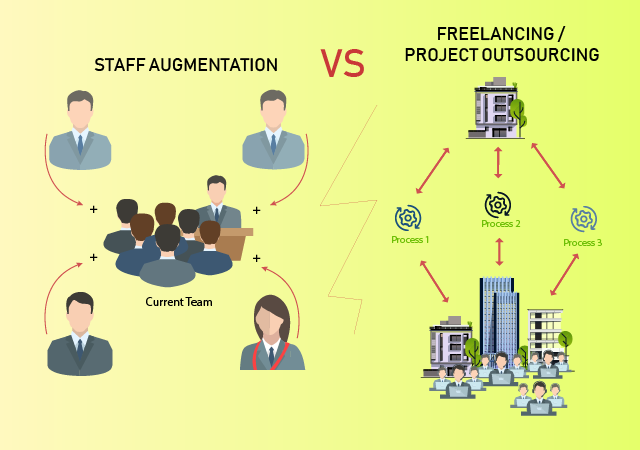IT Staff Augmentation Versus Offshore Outsourcing – Pros & Cons
- Sheryl Jones
- July 16, 2020
- 6 Minute Read

The debate over IT outsourcing versus staff augmentation is one that comes up time and again in management meetings.
Whether you run an IT multinational or a startup with a handful of employees, you’ll find yourself wondering whether to get more hands-on-deck through staff augmentation or outsource complete projects to a specialist firm.
Here’s a telling statistical fact you need to know.
The US Bureau of Labor Statistics predicts that there will be 1.4 million more software development jobs than applicants who can fill in the roles.
Of course, this is just one of the sectors. While the jobs requirement and skilled manpower needs are on the rise, the stiff competition from emerging nations is also making the global markets more volatile.
The only way to survive? Cut down costs, especially on manpower acquisition.
We’ve got more proof. Check these numbers
In the past few decades, offshoring has been on an upward trend. According to Gartner, more than 80% of logistics leaders plan to increase their offshore outsourcing budget by 5% by 2020.
Since global talent shortages are projected to reach 82,2 million by 2030, staff augmentation is the most convenient method of closing the productivity deficit.

Now, the question here is, which way should you go?
Similar to most situations, there is no clear-cut winner when it comes to supremacy. Both have their strengths and drawbacks.
We have resolved to investigate these points and counterpoints in detail.
IT Staff Augmentation: The Best of All Worlds
Staff augmentation entails having supplemental staff work on the project. There is no direct increase in headcount since these employees work for another organization and are delegated to your firm temporarily. You or your HR team has interviewed them, and only those have been selected who have credentials and experience that best suit your needs.
However, in the time of digitization, where the requirements of employers and employees are rapidly changing, it has become quite challenging for HR leaders to source skilled professionals for project-based work. However, leveraging AI based recruitment software that is integrated with various social media and multiple diverse job boards can solve the difficulty of discovering experts that fulfill your requirements.

Staff Augmentation: What’s Good About It?
A lot, really.
- Better Alignment Between People And Projects
Since your augmented staff members work onsite or at least directly with your organization (if they are from overseas), they have a solid grasp of your company’s projects, processes, and goals. Though they might be working for a few months, it is easier to work with staff having knowledge of your processes. This lowers the implementation time frame and reduces bottlenecks.
- Possible To Scale Team-size Up And Down With Ease
Project managers cherish the leverage of easily scaling team sizes. One project might lead to more of the same type from a customer, and in that case, it is easy to hire more through staff augmentation. When the project ends, the augmented staff members return to the parent organization. This innate flexibility is the best aspect of staff augmentation.
- Tight Quality Control
Outsourcing does not allow the project managers to have the granular level of quality control you could exert over someone integrated into your team. With staff augmentation, however, you can expect your people to align closely with your processes and embrace your quality expectations. In the long run, this lowers the resources you have to spare later for maintenance of a system.
- Transparency, Because Of Direct Oversight
Staff augmentation brings you temporary employees who are prepared to change and mould their work to the methods your company trusts. Managers can ensure that the augmented staff members adhere to company policies and can, at all times, influence the process. This oversight removes corporate cultural barriers indelibly present in offshore outsourcing.
IT Staff Augmentation: How To Manage Possible Downsides?
Here are the key aspects you need to know.
- New Staff Has To Be Trained To Align With Your Company Practices
new staff has to be trained in how your teams operate. They have to be made familiar with the internal processes, specific to your organization, and resources have to be spent to achieve this objective. The pressure on line managers increases as they have to ensure that new members have the same understanding and capabilities of tenured employees.
- Increase In Infrastructure, For Onsite Members
For onsite staff augmentation, you will need to provision more office space. Without a doubt, this is the most substantial drawback of the IT staff augmentation process. Rent, furniture, fixtures, and even new hardware are expensive and add to the outlay of working capital required. If the business is located in a city where office space is costly, it can derail your project budget.
- Greater management overhead
Not only physical resources need to increase, but also managerial capabilities are put under strain as more people have to be supervised. To fix the problem, your managers would need to work overtime since there is no possibility of hiring and training new managers in the short run. If the project gets prolonged, you would need to promote current employees to fill the shoes of newly minted project managers.
Offshoring: The Traditional Approach
Several large companies, such as Microsoft and Cisco, have begun outsourcing their work offshore – a practice widely accepted in the business community nowadays. The process of offshoring is completely automated. You ask another company to implement a part of the project. A Deloitte survey has shown that 78% of business owners are satisfied with outsourcing.
It is not only beneficial for cost-cutting but also allows you to tap into an enormous talent pool. Offloading work to subcontractors is profitable and the outsourcing market is expected to reach $531 billion by 2022.
Also Read: What Offshore Outsourcing Will Look Like Post COVID-19
Offshoring: Why It’s Still Relevant
In its broadest sense, offshoring encompasses all its specialized offshoots, including IT staff augmentation. Let’s look at these benefits.
- Does Not Need Recruiting
You no longer have to bear the headache of locating and onboarding talent. This can free up resources for you to devote to research or even refining your products and services and making them more competitive. In essence, you focus on what you do best and allow others to deliver to you what they do best.
- Reduce Training Cost
You spend less time training and monitoring your employees’ performance. Therefore, the training is more efficient and allows you to devote resources to more profitable and complex projects. You only need to explain the parameters to the outsourcing company, and they will handle the assignment.
- Access To More Talent
It might be difficult for HR to locate professional front-end developers who are experts at writing ETL pipelines using Python and willing to work for five months. On the other hand, in another part of the world, there may be a wealth of such coders with expertise shared through the community. This allows offering to be a true division of labor – everyone does what they are best at and maximizes profits.
- Can Get Results Quicker, Particularly For One-off Projects
Offshore outsourcing is particularly helpful when you receive a project out of your domain of expertise. It makes little sense to hire staff and train them for a few weeks’ worths of work. Also, your managers may not have the knowledge to oversee the development of the project. Offshoring, especially to a regular contractor, is a cheap and quick solution.
Offshore Outsourcing: Where It Falls Behind IT Staff Augmentation
To overcome these downsides, consider the more specialized staff augmentation approach
- Lack of control
The development process is completely outside of your control. You are exposed to outcomes in stages. The result – almost at every stage of a project, you will need to absorb many deviations from expectations, in the interest of continuity.
- Lack of security/fear of espionage
There is no possible way that you could ensure that details of your project are not being studied for reverse engineering by your rivals. Even if you have agreements about not sharing proprietary material, once the project is out of your hands, you have no way of checking whether it is being copied.
- Cultural Misfitting
For important projects, you need people who bring skill, as well as allegiance to your company’s culture, to the table. The advantages of outsourcing are purely cost-related, and you lose out on the affiliation an in-house employee usually provides. This is among the leading objections many business leaders have to outsource.
IT Staff Augmentation vs. Offshoring – Which Is Better?
Technology delivery models come with a lot of what-ifs. There are variables in play that range from domain knowledge to excess office space, cost escalation, and myriad other factors.
The natural choice from the point of view of quality control would be staff augmentation, particularly onsite augmentation. If that is not possible and not beneficial in terms of yield, then offshore outsourcing is the next best option.
At the end of the day, you might end up with a hybrid model that allows you to adjust various factors and ultimately end up with the best of both worlds.


Thank you for submitting the details!
We will keep your information safe. Feel free to contact us with any questions at hello@uplers.com
Please check your email for next steps shared by Robert.















